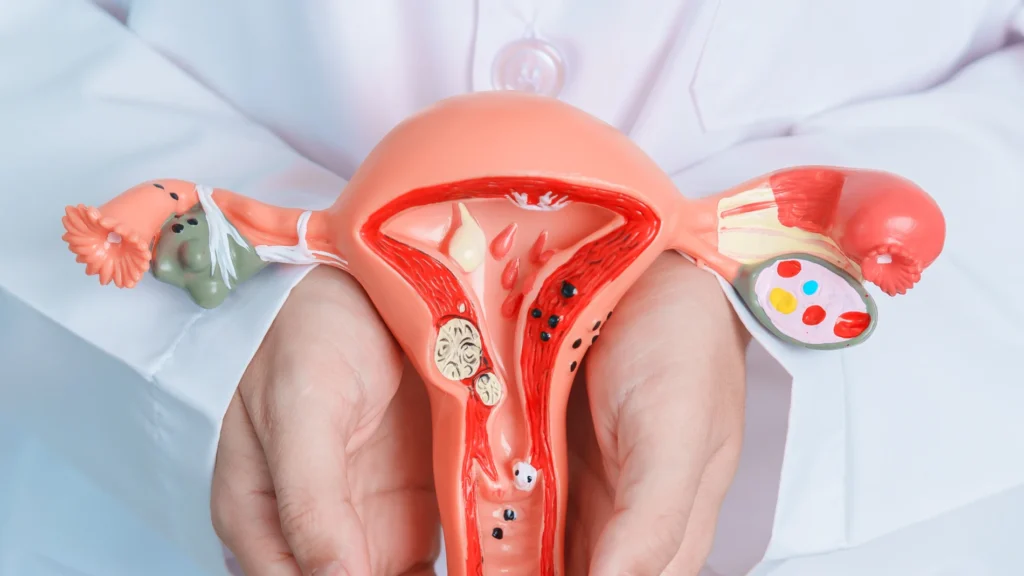Polycystic Ovary Syndrome (PCOS) is a multifaceted hormonal disorder affecting millions of women globally. Given its wide range of symptoms, many women ask, “What type of PCOS do I have?” Understanding your specific subtype is crucial for developing a tailored treatment plan that targets your unique symptoms. Let’s explore the different subtypes of PCOS and how to determine which one affects you.
Need help with PCOS? Visit a specialist in Brooklyn today.

What Is PCOS and Why Are There Different Types?
PCOS is characterized by hormonal imbalances, irregular periods, and often the presence of small ovarian cysts. Though its exact cause remains unclear, PCOS likely results from a combination of genetic and environmental factors. The varied symptoms and presentations of PCOS have led researchers to classify it into distinct subtypes.
The Four Types of PCOS
There are four commonly recognized subtypes of PCOS, each with unique characteristics:
- Insulin-Resistant PCOS: The most common type, marked by insulin resistance, high insulin levels, and elevated androgens.
- Post-Pill PCOS: Occurs after discontinuing birth control pills, leading to temporary hormonal imbalances and irregular periods.
- Adrenal PCOS: Involves the adrenal glands producing excessive androgens, resulting in acne and hirsutism (excessive hair growth).
- Inflammatory PCOS: Characterized by chronic inflammation, which may be connected to autoimmune disorders.
Symptoms That Help Identify Your Type of PCOS
The specific symptoms you experience can help determine your PCOS subtype:
- Insulin-Resistant PCOS: Irregular periods, acne, weight gain, excessive hair growth, and dark patches of skin (acanthosis nigricans).
- Post-Pill PCOS: Irregular periods, acne flare-ups, mood swings, and possible weight gain after stopping birth control.
- Adrenal PCOS: High androgen symptoms such as acne, hirsutism, and irregular periods.
- Inflammatory PCOS: Symptoms of inflammation, such as fatigue, joint pain, food sensitivities, alongside typical PCOS symptoms.
How PCOS Is Diagnosed: Tests and Evaluations
Diagnosing PCOS involves a combination of physical exams, lab tests, and imaging studies:
- Physical Examination: Your healthcare provider will assess your weight, check blood pressure, and look for signs of elevated androgens (e.g., excess facial hair, acne).
- Pelvic Ultrasound: This imaging test identifies cysts on the ovaries, a common PCOS indicator.
- Blood Tests: Blood work is used to measure hormone levels (testosterone, LH, FSH) and assess insulin resistance.
- Additional Tests: Depending on your symptoms, your doctor may order thyroid function tests or glucose tolerance tests to rule out other conditions.
Which Type of PCOS Do I Have? A Step-by-Step Guide
- Track Your Symptoms: Document your menstrual cycle, weight changes, and any new or worsening symptoms.
- Consult a Doctor: Share your symptoms with your healthcare provider, who will conduct a thorough examination and order relevant tests.
- Review Test Results: Work with your doctor to interpret your test results and match your symptoms with the most likely PCOS subtype.
- Consider Genetic Testing: In some cases, genetic testing may offer additional insights, helping to fine-tune your treatment plan.
Treatments Based on PCOS Type
Once your subtype is identified, your doctor will recommend personalized treatment options:
- Lifestyle Modifications: Focus on a healthy diet, regular exercise, and stress reduction to improve insulin sensitivity and overall health.
- Medications: Common options include birth control pills, metformin (for insulin resistance), and anti-androgen medications.
- Surgery: In rare cases, surgical options like ovarian drilling may be recommended to remove cysts or manage severe symptoms.
Managing PCOS Long Term: What You Need to Know
Successfully managing PCOS requires long-term commitment. Consider these tips for maintaining your health:
- Stay Engaged with Your Healthcare Team: Regular check-ups allow for monitoring and adjusting your treatment as needed.
- Adopt Healthy Habits: Prioritize a balanced diet, regular physical activity, and mental well-being.
- Join a Support Group: Connecting with other women living with PCOS can provide emotional support and valuable advice.
- Be Your Own Advocate: Stay informed, ask questions, and seek second opinions if your treatment isn’t meeting your needs.
Conclusion
While PCOS comes in different forms, understanding your specific subtype allows for more effective treatment. Whether dealing with insulin resistance, adrenal imbalances, or post-pill symptoms, the goal remains the same: to manage your symptoms, improve your quality of life, and reduce the risk of long-term complications. With the right care and lifestyle adjustments, living well with PCOS is entirely possible.